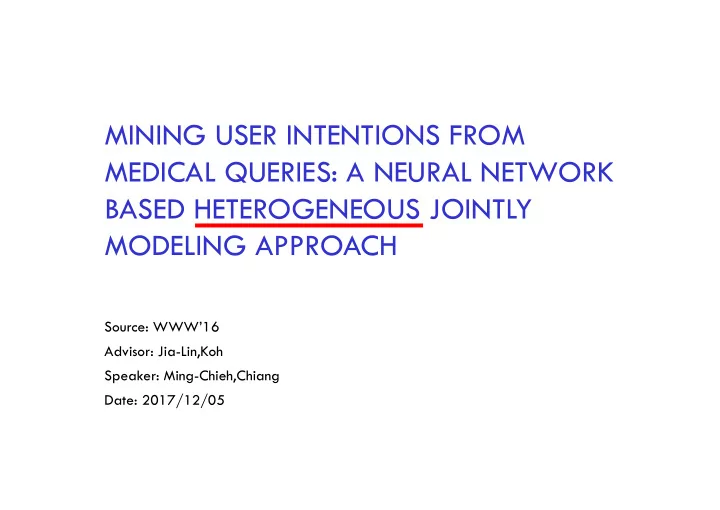

MINING USER INTENTIONS FROM MEDICAL QUERIES: A NEURAL NETWORK BASED HETEROGENEOUS JOINTLY MODELING APPROACH Source: WWW’16 Advisor: Jia-Lin,Koh Speaker: Ming-Chieh,Chiang Date: 2017/12/05
Outline Introduction Method Experiment Conclusion 2
Introduction Motivation Text queries are naturally encoded with user intentions Words from different topic categories tend to co- occur in medical related queries This work aims to discover user intentions from medical-related text queries that users provided online 3
Introduction Goal Input : medical query Output : intentions 4
Introduction Definition of intention By describing related information in concept s, the user is looking for corresponding information about concept n. 5
Outline Introduction Method Experiment Conclusion 6
Architecture 7
Feature-level modeling Pairwise feature correlation matrix sim(Mi,Mj) : the similarity between feature Mi and Mj 8
Feature-level modeling Convolution operation k filters tk : weight matrix x : convolution region bk : bias f : ReLU(x) = max(0,x) 9
Feature-level modeling Pooling operation a subsampling function that returns the maximum of a set of values 10
POS tagging POS tagging is used as word categories Calculate the number of occurrence of each tag Fully connected layer : estimate the contribution of different POS tags 11
Jointly modeling To overcome the domain coverage challenge. “ I have been taking Tylenol .” “ I have been taking aspirin” Tylenol & aspirin : the word category is “n-medicine” Concatenate results and reduce dimension 12
Increasing model generalization ability Data augmentation To reduce overfitting Sentence Rephrasing Use the nearest neighbors of a word in a vector space to generate candidate rephrasing words Constrain original word and candidate words with a equality constraint on POS type as well as similarity constraints 13
Increasing model generalization ability Data augmentation Calculate the nearest neighbors of words Check each candidate word that whether it has the same tag with each word Use threshold for the similarity measurement If the new word meets those constrains, then replacing this old word by the candidate word to generate a new query 14
Increasing model generalization ability Dropout A regulation method to overcome co-adapting of feature detectors To reduce test error Dropout layer is applied after each pooling layer with 0.5 probability 15
Outline Introduction Method Experiment Conclusion 16
Dataset corpus : http://club.xywy.com/ 64 million records Pre-processing : word segmentation Use word2vec to train vector representation of words The vectors have dimensionality of 100 and were trained using the Skip-gram Window size : 8 Minimum occurrence count : 5 17
Baseline methods SVM-FC (Feature-level Correlation) LR-FC (Logistic Regression) NNID-ZP (Zero Padding) NNID-FC NNID-JM (Jointly Modeling) NNID-JMSR (Sentence Rephrasing) 18
Performance 19
Performance 20
Performance 21
Case 22
Outline Introduction Method Experiment Conclusion 23
Conclusion Intention detection for medical query will provide a new opportunity to connect patients with medical resources more seamlessly both in physical world and on the WWW Present a jointly modeling approach to model intentions that users encoded in medical related text queries The method can be generalized and integrated into other existing applications as well 24
Recommend
More recommend